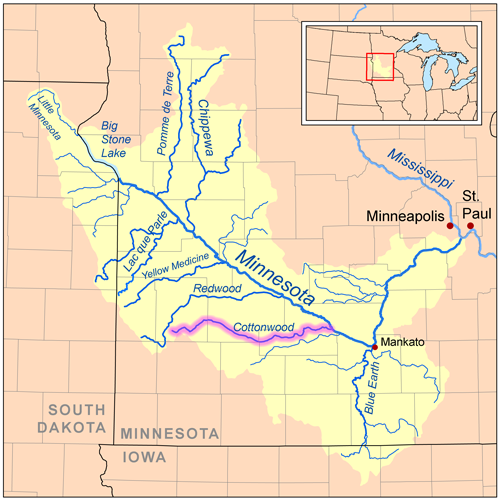The
concept of a watershed has long captured my imagination. A watershed is made up of the area that
drains to a common waterway. I don’t
know why this has always been of interest to me. It may go back to when I was quite young and
my mother took us me to play along Little Cottonwood Creek near where she grew up in
rural southwest Minnesota. She taught my
brothers and me to skip rocks. She told
us how she used to play along the creek and think about how the creek drained
into the Cottonwood Creek which drained into the Minnesota River which drained into the Mississippi River, which
emptied into the Gulf of Mexico. I later
took my daughters to play along the same creek.

Much
of my life has been shaped by the Mississippi River watershed. I grew up in Illinois, not too far from the
Mississippi. I lived in Louisiana in the
delta of the Mississippi. Afterward, I lived
in Minnesota for quite a few years and daily crossed the river to get to the
University of Minnesota. One summer I
finally got to the headwaters of the Mississippi, in Ithasca State Park. There I walk across the mighty Mississippi,
thinking about how this stream connected with the river I crossed in the Twin
Cities, the Mississippi I knew that separated Iowa and Illinois, and the river
whose sediment created a landscape just above sea level in Louisiana.
This
is what attracts me to rivers and their watersheds. Even the smallest creek flows somewhere—it
has direction to it. My grandmother’s
high rise apartment building, in Windom, MN overlooked the Des Moines
River. For more than a decade I lived in
southeastern Iowa within a couple of miles of the Des Moines River. Every Sunday I would take a long walk along
the river, always thinking of being connected with my grandmother
upstream.
When
I received a Fulbright Fellowship to the University of Guelph, in Ontario, I
left my Mississippi watershed behind.
In southern Ontario, the land drains into the Great Lakes and down the St. Lawrence
River into the Atlantic. Soon after my Fulbright, I
actually moved to Michigan, leaving the Mississippi watershed to
remain in the St. Lawrence watershed.
Several
weeks ago I recognized my on-going connection with the St. Lawrence in a public event. With a grant from the Canadian Fulbright
Association, a group of volunteers planted rain gardens in the Plaster Creek
watershed of Grand Rapids, Michigan, where I lived for 16 years. These rain gardens increase the
infiltrate of rainwater. This reduces
storm water from rushing into the stream and also allows for the natural
filtering of the water to decreases pollution. I began this effort in 2004 with others in what was called the Plaster
Creek Working Group. Others are now leading what has grown into the Plaster Creek Stewards which
involves the public in on-the-ground restoration activity somewhere in the
watershed (e.g. labeling storm drains, planting rain gardens). To date seven
churches, two businesses, two schools, and over 100 residents have been
involved in activities related to Plaster Creek.
This particular
effort was funded by the Fulbright Foundation of Canada, in recognition of how
the lives and actions of those living in the Plaster Creek watershed affect our
Canadian neighbors downstream. Plaster
Creek is part of the Grand River Watershed which empties into Lake Michigan and
drains through the Great Lakes and out the St. Lawrence River. The waterways and their watersheds connect us and make the need for a mutual commitment to
each other necessary. It is a reminder that rivers
lead "somewhere" and that others live in that "somewhere."
Wes
Jackson says in his book, Alters of
Unhewn Stone (NY: North Point Press, 1987: 155):
What if we employed our rivers and
creeks in some ritual atonement? Their
sediment load is largely the result of agricultural practices based upon
arrogance, tied in turn to an economic system based upon arrogance…but perhaps
we need an annual formal observance in the spring—when the rivers are
particularly muddy--a kind of ecological rite of atonement, in which we would
“gather at the river.” Maybe we should ally ourselves by virtue of a common
watershed…for a watershed can and often does cut through more than one
bioregion. There would be nothing
abstract about a common covenant among people of a common watershed.
My hope is
that each of us may move beyond the abstract in how we live each day in our
watershed.
 |
| Photos by Gail Heffner |
 |
| Dennis Moore from the Canadian Consulate in Detroit |





No comments:
Post a Comment